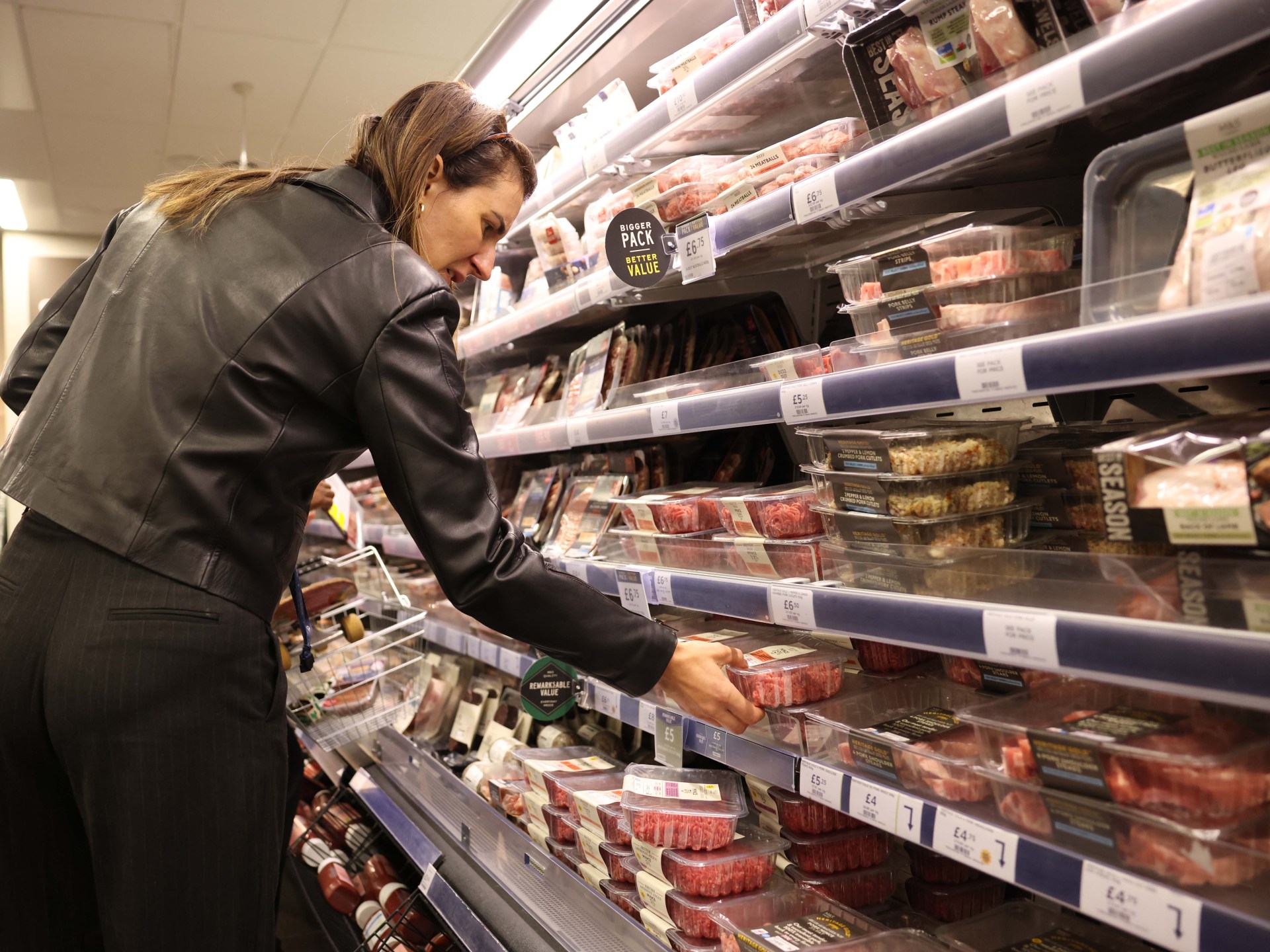Timelapse video from Indonesia shows Mount Lewotobi Laki-Laki erupting on Flores island, sending ash 10 kilometres above its 1,584-metre peak. It’s the volcano’s third major eruption since July.
Timelapse video shows Indonesian volcano erupting


Timelapse video from Indonesia shows Mount Lewotobi Laki-Laki erupting on Flores island, sending ash 10 kilometres above its 1,584-metre peak. It’s the volcano’s third major eruption since July.

While reflecting on his younger years, Brian Cox admitted he believes he “failed” in his first marriage after getting hitched at the young age of 21.
The Succession star, 79, opened up about the breakdown of that relationship and other challenges he faced while growing up during an appearance on the Coaching Stories podcast with Dr Sam Humphrey.
Brian married his first wife, Lilian Monroe-Carr, in 1966 but the couple split just a year later. He spoke about that time in his life, saying: “The only time I failed, I think, is probably in my private relationships. Certainly with my first marriage, it was not easy, and I think that’s where I kind of fell down.
READ MORE: Katie Price reveals stretched face as fans left concerned over weight loss
READ MORE: Tony Caunter dead: EastEnders icon who played Roy Evans in BBC soap dies aged 88
“Professionally, everything was in good nick, but I got married when I was very young. My mother used to say: ‘Brian, don’t get married too young. Your brother, affy stupid, got married when he was 20. Don’t get married when you’re 20’. I got married when I was 21… and I think I did get married too young.”
After that brief marriage ended in 1967, the Dundee-born actor went on to tie the knot with Caroline Burt in 1968. The pair were together for nearly two decades and had two children — Margaret and Alan, who followed in his father’s footsteps by becoming an actor. Brian and Caroline then got divorced in 1986.
The actor later found lasting love with German actor and yoga instructor Nicole Ansari-Cox, who he married in 2002. They share two sons, Orson Jonathan and Torin Kamran.
During the podcast, Cox also touched on his difficult childhood, which was filled with instability after the death of his father when he was just eight years old.
His mother’s subsequent mental health struggles left him to navigate much of his early life alone. “I was basically on my own from the age of eight until about 11,” he shared.
“I used to go to the cinema all the time. As a kid, I just went to the cinema endlessly. We had 21 cinemas in Dundee at one point, and I visited them all. I used to go on my own.”
Dr Humphrey, the podcast’s host and CEO of Grit Coaching, praised Brian for his candour after the interview, saying: “Brian was surprisingly open, vulnerable, and deeply personal in our discussion. It can be easy to brush past mistakes aside and not dwell on them — his honest account will no doubt inspire so many others.”
Brian is best known for his role as media mogul Logan Roy in HBO’s Succession, but the Emmy winner recently took on a very different challenge as The Controller in Prime Video’s 007: Road to a Million.
He described the second series of the reality show as “infinitely more dramatic” ahead of its premiere in August 2025, and added that he enjoys exploring the psychology of the contestants as they face high-stakes challenges.

EastEnders star Pam St Clement has shared a moving tribute to her former on-screen husband Tony Caunter, after his death was announced on Tuesday.
Tony, who played Roy Evans on the BBC soap, died just eight days after his beloved wife of 63 years passed away.
In a statement provided to The Sun, Tony’s former co-star Pam said: “I am very saddened to hear of Tony’s passing. He was not only a lovely man, but a true gentleman to work with.”
The sad news of Tony’s death was announced in a statement by the actor’s family yesterday. They said: “It is with enormous sadness that we bring the curtain down on our wonderful and hugely loved father, Tony Caunter, who died peacefully yesterday evening, just eight days after his beloved wife of 63 years, Fran, also passed away.
“Dad was 88 years old. After a long and fulfilling life on and off screen and stage, Tony leaves a daughter and three sons, seven grandchildren and four great-grandchildren. He will be missed by all.”
The family went on to praise the care Tony had been given in his final months.
They added: “We would like to thank the NHS staff at Eastbourne District General Hospital for their incredible care during his final hours, and to everyone at Eastbourne Gardens nursing home for the care and compassion they have given dad over the past two months.”
EastEnders have paid tribute to their former cast member, highlighting his on-screen marriage to Pam St. Clements’ Pat Butcher.
The show said in a statement: “It is with great sadness that we learn of the passing of Tony Caunter.
“Tony will forever be loved and respected by everyone at EastEnders for his warmth, kindness and humour as well as being greatly remembered by all those at home who instantly took Roy to their hearts.
“Roy will always be remembered for his great love of Pat, despite him famously declaring his distaste in her choice of earrings, which gave us all one of Walford’s greatest love affairs.
“Tony will never be forgotten by all those who worked alongside him for many years and everyone at EastEnders sends their love and condolences to Tony’s family and friends.”

As well as his role in EastEnders, Tony also appeared in The Avengers, Casualty, The Sweeney, Minder, and Queenie’s Castle.
He retired from acting a few years after leaving the soap, with his final credit being an episode of Doctors in 2008.
This is a breaking news story.

Over the weekend Rochelle Humes and her family gathered to celebrate her son Blake’s fifth birthday party, with Rochelle nailing the ultimate chic and comfortable outfit for the occasion. Opting for a leather jacket and a pair of wide leg jeans, the look was the perfect choice for an afternoon of dancing and running around after little ones.
Rochelle’s jeans were a classic pair of Levi’s, and look to be the Cinch Baggy Lightweight Jeans which have the same wide leg shape whilst still being super fitted around the waist. You can pick up the exact pair for £70 direct from Levi’s, and although Rochelle opted for the black pair, you can also snap them up in five other colours.
READ MORE: Emma Louise Connolly’s ‘beautifully made’ Boden trousers are ‘selling like hotcakes’
READ MORE: Exact cosy fingerless gloves Claudia Winkleman wears on The Traitors are back in stock
As well as a good choice of colours, the Cinch Baggy Lightweight Jeans also come in a huge range of sizes and length options, so you can find the perfect fit for your body. You can opt for waist sizes from 23 to 32, and you can choose from 29, 31 and 33 inch leg lengths.
The jeans are the perfect choice for anyone who loves the wide leg look but is sick of ending up with a baggy waistband that gapes. Although the legs are cut into a wide, straight style, the 12.5 inch high rise waist features adjusters on the back which let you get a tailored fit without forking out for a seamstress.
The Cinch Baggy Lightweight Jeans have a relaxed fit that’s ultra comfortable and easy to move around in (making them the perfect choice for Rochelle’s child’s birthday party) and are made from 100% cotton for a draped fit. This also means they’ll retain their shape, with no elastane to get stretched out.
There’s plenty of similar styles on the high street that are a little more affordable, but that don’t feature the adjustable waistband. At Marks & Spencer the Autograph High Waisted Wide Leg Jeans are £55 and come in sizes six to 24, with petite, regular and tall leg lengths available.
At Next the £52 Black High Rise FlexiFit Stretch Pull On Wide Leg Jeans have a more fitted design around the hips and waist, before flaring out into a wide leg silhouette with petite and regular lengths. For the ultimate bargain, Abercrombie & Fitch has slashed the price of its High Rise Wide Leg Jean from £75 to £44.99, with seven different colours to choose from – although they are selling out quickly.
Whilst Levi’s Cinch Baggy Lightweight Jeans might be a little pricier than other brands, their adjustable waist and quality has made them super popular with shoppers. One said they were: “My most favorite jeans ever!!!!! I have 3 colors and they are all worn weekly. Genuinely so grateful I found jeans that look good on me!”
Another agreed: “Very relaxed fabric compared to most Levi’s jeans, which are a nice addition to my stiff closet thus far (love both types for different uses)! They fit really well sizing wise. I am typically a 26 and got a 26. The button in the back to adjust waist was INCREDIBLE to fix the slight gap issue that I often have with thicker thighs. This wash is so timeless! Overall, very happy!”
Whilst a third said: “Love these jeans. They are so soft and comfortable. The high waist is very flattering. Perfect length.”
Some found the fit around the hips a little tricky to nail, with one saying: “Really nice fit, but I had to go a size bigger as it was tight on the hips and buttocks area.”
Someone else wrote: “They’re very tight and hard to move in. But they are very comfortable and the style is cute. The durability feels okay not too good or bad.”
However another said: “I love these jeans! They aren’t super thick and very relaxed. I love the style of them and have gotten a lot of compliments since I started wearing them! They are true to size and are very flattering. I highly recommend the cinch pants!!”

Far-right American influencer Candace Owens has lost a legal bid to be allowed to enter Australia after a court ruled with the government that granting her a visitor visa could “incite discord in the Australian community”.
The High Court of Australia said in its ruling on Wednesday that the government’s decision to refuse Owens a visa in 2024 “was not invalid” and ordered her to pay the government’s legal costs in the case.
list of 4 itemsend of list
The court “unanimously” ruled that the article in Australia’s Migration Act used by the government against Owens “applies where, in the event that the person were allowed to enter or to remain in Australia, there is a risk that the person would stir up or encourage dissension or strife in the Australian community, or a segment of that community”.
Owens, a well-known right-wing podcast host and political pundit who has built a large online following for controversial views and conspiracy theories, applied for an Australian visa to undertake a commercial speaking tour in November 2024.
Australia’s Home Affairs Minister Tony Burke – who has the powers to deny noncitizens entry based on a “character test” – rejected Owens’s application in October 2024 due to the risk of her views “leading to increased hostility and violent or radical action”.
Burke had cited her public comments on the Holocaust and other Islamophobic remarks.
“From downplaying the impact of the Holocaust with comments about Mengele through to claims that Muslims started slavery, Candace Owens has the capacity to incite discord in almost every direction,” the minister said last year, according to Australia’s Herald Sun news outlet, referring to Josef Mengele, the Nazi physician who conducted experiments on Jewish prisoners at Auschwitz.
The High Court of Australia has delivered its ruling in the battle between Immigration Minister Tony Burke and a controversial American right-wing influencer. > https://t.co/Caf2KV6zMQ pic.twitter.com/Gyi8l6kkKm
Owens appealed the minister’s decision to the High Court on the grounds that refusing her a visa infringed on freedom of political communication, though in Australia – unlike the United States – there is no express constitutional right to free speech.
“The implied freedom is not a ‘personal right’, is not unlimited and is not absolute,” High Court Judges Stephen Gageler, Michelle Gordon and Robert Beech-Jones said in their joint judgement on the case.
The judges noted that Burke had denied Owens a visa after examining her views and comments on areas including antiracism, Black Lives Matter, anti-Semitism, women’s and LGBTQ rights, COVID-19 and anti-vaccination.
Burke had found her views to be “extremist and inflammatory comments towards Muslim, Black, Jewish and LGBTQIA+ communities which generate controversy and hatred”, and the minister concluded that she had failed the “character test” required for a visa and that allowing her into the country would not be in the national interest, the judges said.
Owens’s “submissions should be emphatically rejected”, High Court Judge James Edelman said in a separate judgement.

You go into a store to buy a two-litre bottle of milk at your local supermarket and pay $3. But the person before you in the queue paid $3.50. And the person after you paid $2. What if those prices were based on your personal data or circumstances, or even the battery power on your phone?
This may sound like science fiction, but it’s not as far-fetched as you might think.
In July, US group Delta Air Lines revealed that approximately 3 percent of its domestic fare pricing is determined using artificial intelligence (AI) – although it has not elaborated on how this happens. The company said it aims to increase this figure to 20 percent by the end of this year.
The news raised concerns among consumers that Delta might be using customers’ data to determine what to charge them. So, US Senators Mark Warner, Ruben Gallego and Richard Blumenthal sent a letter to Delta Air Lines requesting further information about its reported plans to implement AI-driven “dynamic pricing”.
“Delta’s current and planned individualised pricing practices not only present data privacy concerns but will also likely mean fare price increases up to each individual consumer’s personal ‘pain point’ at a time when American families are already struggling with rising costs,” the letter stated.
Although Delta did not deny using AI to set prices, it replied, telling the senators that it does not use it for “discriminatory or predatory pricing practices”.
According to former Federal Trade Commission Chair Lina Khan, however, some companies are able to use your personal data to predict what they know as your “pain point” – the maximum amount you’re willing to spend for a specific good or service.
In January, the US’s Federal Trade Commission (FTC), which regulates fair competition, reported on a surveillance pricing study it carried out in July 2024.
It found that companies can collect data directly through account registrations, email sign-ups and online purchases in order to do this. Additionally, web pixels installed by intermediaries track digital signals including your IP address, device type, browser information, language preferences and “granular” website interactions such as mouse movements, scrolling patterns and video viewing behaviour.
This is known as “surveillance pricing”.
Surveillance pricing is the practice of monitoring consumer data to set individualised prices in order to maximise profits for the retailer.
Put simply, having access to your personal information enables retailers to charge you the most they think you will be willing to pay.
In a 2024 research paper, Oren Bar-Gill, legal scholar and economist at New York University, describes surveillance pricing as follows: “Fuelled by big data, algorithmic price discrimination enables sellers to parse the population of potential customers into finer and finer subcategories – each matched with a different price.
“In some cases, sellers are even able to set personalised pricing, marching down the demand curve and setting a different price for each consumer.”
In an interview with economist Robert Reich in July this year, Khan said: “Evidence shows that ride-sharing apps are charging different prices for the exact same rides at the exact same time. It’s not entirely clear, but researchers ran tests and found that riders with lower battery life on their phone were charged more.”
Delta Airlines reportedly wants to use AI to set individualized ticket prices for passengers.
It’s the latest company to embrace a shady tactic called “surveillance pricing” that weaponizes your personal data.
Watch Lina Khan explain how it works. pic.twitter.com/pnRJTyLZq6
Uber denies it is deliberately targeting any of its app users with higher prices. However, its former head of economic research, Keith Chen, did reveal in an NPR interview in 2016 that the company had discovered that users with low battery life were more likely to accept surge pricing.
“Uber has found that those with a low battery tend to accept the surge price regardless, because they need a ride home that minute, instead of waiting an extra 15 for the surge to possibly go down.
“We absolutely don’t use that to kind of push you a higher surge price, but it’s an interesting kind of psychological fact of human behaviour.”
Then, in 2023, an investigation by Belgian newspaper La Derniere Heure also found that prices for the same journey on the Uber app can be different for different users. In particular, its test found that the same ride from the newspaper’s office in Brussels would cost more ordered from a phone with 12 percent battery – 17.56 euros ($20.51) than from one with 84 percent – 16.60 euros ($19.39).
When approached for comment, Uber denied this, stating: “Uber does not take into account the phone’s battery level to calculate the price of a trip. The dynamic pricing applied to trips booked via Uber is determined by the existing demand for rides and the supply of drivers who can respond to it.”
Retailers can monitor your online behaviour by recording what you click on, your browsing time, location and device choice and combine all this with your purchase history to determine your “price sensitivity”.
“Price sensitivity” typically measures how much customers’ buying behaviours change in response to shifts in product prices.
To do all this, they use AI surveillance tools to produce pricing recommendations. These sophisticated systems operate across a spectrum, from broad store-wide pricing strategies to personalised, real-time price adjustments tailored to individual user behaviour patterns.
A wide range of consumer-facing businesses – both online-only and high-street retailers – including grocery, apparel, health and beauty, home goods, convenience, hardware and general merchandise retailers, were included in the January FTC surveillance pricing study.
According to the study, these are some of the ways retailers are using surveillance pricing to various degrees:
Retailers are using AI to gather detailed information about consumers, including login data, location, browsing behaviour, “abandoned cart items”, and even mouse movement patterns, and then feeding this information into pricing algorithms.
AI assesses an individual’s willingness to pay (WTP), then systematically tests various price points to identify the optimal price which will generate the most revenue.
“Sellers are increasingly utilising big data and sophisticated algorithms to price discriminate among customers,” says Bar-Gill. “Indeed, we are approaching a world in which each consumer will be charged a personalised price for a personalised product or service … many retailers and travel sites set personalised prices that vary by hundreds of dollars from one consumer to the next.”
He adds that intermediaries who specialise in identifying consumers’ willingness to pay (WTP) and sell this information to retailers have also begun to emerge.
Yes, but it is increasingly being called into question.
This year so far, US state legislators have introduced 51 bills across 24 states aimed at regulating algorithmic pricing, a significant rise from the 10 bills passed in all of 2024.
Many of these legislative measures specifically target rent-setting software, which enables price-fixing in housing markets. Advocates are also pushing for limits on surveillance-driven pricing that tailors costs based on personal data, location or browsing behaviour.
In particular:
Other countries are also introducing regulations. As of April 2025, the Digital Markets, Competition and Consumers Act DMCCA lets the Competition and Markets Authority (CMA), the United Kingdom’s main competition regulator, fine companies up to 10 percent of global revenue for unfair or misleading consumer practices, including hidden or biased digital pricing.
Public participation and regulatory legislation will continue to play an important role in reducing the risk of corporations using personal data for unfair pricing practices.
Not really – it’s more that the name of this practice has changed over time. It has previously been known as “price discrimination” or “dynamic pricing”.
In 2008, Norwich Union, the UK’s largest insurer, now called Aviva, discontinued its “Pay As You Drive” car insurance policy due to customer fears about surveillance and privacy.
The “Pay As You Drive” scheme used satellite technology and tracking devices to monitor drivers’ travel patterns, providing discounted premiums to customers who avoided high-risk driving periods.
Today, many UK insurers provide surveillance equipment known as a “black box”, which new drivers plug into their cars. The better you drive, the lower your premiums.
In the 2000s, Amazon experimented with dynamic pricing, offering varied DVD prices using customer browsing data and website cookies. After many customer complaints, debates about fairness and transparency in e-commerce began. Some critics argued Amazon’s practice resembled price discrimination, raising ethical concerns.
Amazon said the pricing experiment selected random customers only and denied intentionally targeting specific buyers.
However, in a September 2000 statement, Amazon issued an apology to customers regarding the price-testing programme and said it had ceased the experiment.
“We’ve never tested and we never will test prices based on customer demographics,” Amazon CEO Jeff Bezos said in a statement. “What we did was a random price test, and even that was a mistake because it created uncertainty for customers rather than simplifying their lives.”
The FTC Surveillance Pricing report lists several ways in which consumers can protect their data.
These include using private browsers to do your online shopping, opting out of consumer tracking where possible, clearing the cookies in your history or using virtual private networks (VPNs) to shield your data from being collected.
It noted, however, “These steps can be difficult to maintain and may not be fully effective, since many companies use device fingerprinting or other less obvious tracking methods.”
Device fingerprinting allows companies to track people by using unique information from their devices, such as their browser settings and what hardware and software they use.
Consumers can also use “private mode” when browsing to hide their activity or just share less personal data. However, advanced tracking technologies still make it difficult to fully escape surveillance-driven pricing mechanisms.